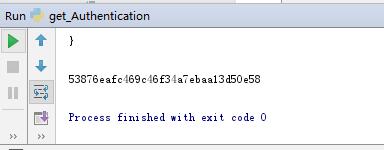前言:
1、开放的接口为了避免被别人攻击,频繁刷接口,浪费服务器资源,这就涉及到签名(Signature)加密了
2、API 使用签名方法(Signature)对接口进行鉴权(Authentication)。每一次请求都需要在请求中包含签名信息, 以验证用户身份。
一、我们的接口请求:
1、登录的url + key(一段已知的字符串) + get请求带上固定参数(有一个变动的时间戳)拼接成新的请求链接
2、拼接之后的链接通过 hashlib.md5 加密
3、加密之后的数据就是鉴权ydtoken
5、再把这个ydtoken传到每个接口请求的参数里面去,请求才能成功
二、鉴权的代码操作
# -*- coding:utf-8 -*- from common import commons import readConfig as readConfig import hashlib localReadConfig = readConfig.ReadConfig() class getAuthentication(object): def get_Url(self,xlse_name,name,row=0,col=1): ''' 从excel里面获取登录的url,账号和密码,然后 url+固定参数,拼接成新的请求链接URL ''' api_v = localReadConfig.get_http('api') local_xls = commons.get_xls(xlse_name,name) url = local_xls[row][col] par = self.add_par() get_url = '/'+api_v+url + "?" + par return get_url def add_par(self): # 固定参数:时间戳+固定参数,拼接成 a=1&b+2&c=3 的模式 fixed_parameter= localReadConfig.get_parameters() list_a=[] for key in dict(fixed_parameter): list_a.append( key+'='+fixed_parameter[key]) list_b = '&'.join(list_a) return list_b def get_ydtoken(self,url): # 拼接之后的链接URL + 固定字符串 就行md5 加密,生成鉴权数据 # print((md5str)) key = "固定字符串" new_md5str = key + url # print(new_md5str) byte_md5str = bytes(new_md5str, encoding="utf8") #必须传byte ydtoken =hashlib.md5(byte_md5str).hexdigest() return ydtoken
运行后的结果:

三、fiddler抓看响应时间,是加密后的数据,需要使用base64解密

代码操作
def get(self): try: r = requests.get(self.url, headers=self.headers, params=self.params, timeout=float(timeout)) print(r.url) result = decodeToBase64(r.content) #decodeToBase64封装了解密方法,每个公司都会做一些改动,就不贴出来了 response = json.loads(result) # response.raise_for_status() return response except TimeoutError: self.logger.error("Time out!") return None
解码之后:




